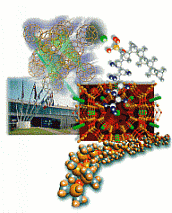
Characterizing Materials Using X-ray and Neutron Scattering
by
- Lecture: Tuesdays, 2:10pm - 3:30pm in room
- Computer class: Thursdays, 9:00am - 12:00am in room 346, Giltner Hall
Welcome to the information pages for the graduate course PHY905-2 on characterizing materials using scattering, that will be held for the first time in the fall semester 1999. If you have any questions please feel free to contact Prof. Simon Billinge (email: billinge@pa.msu.edu) or Dr. Thomas Proffen (email: proffen@pa.msu.edu). Note that the course is limited 20 so don't wait too long with signing up ...
This course will cover the basics of diffraction and scattering with an emphasis placed on gaining an intuitive understanding of the scattering process. We will give an overview of the kinds of problems in materials science which can be studied using scattering, and the scattering techniques themselves. Students will carry out detailed case-studies on selected problems.
The course will make extensive use of computer simulation techniques keeping to a minimum the amount of mathematical formalism which is required. Emphasis will be placed on modern neutron and synchrotron based approaches.
- Intuitive understanding of the scattering process (about 25% of the course)
- Scattering from simple slit and double slit
- Scattering of a single object up to small aggregates of objects
- Simulating the scattering result on the computer using the program DISCUS
- Concept of Fourier Transform and its properties
- Going from a small number of atoms to crystals
- Concept of reciprocal space and its relation to real space
- Real versus perfect crystals (even more computer simulations)
- Experimental basics of scattering (about 10% of the course)
- Radiation sources (X-ray tube, synchrotron and spallation neutron sources)
- Typical experimental setups (e.g. Powder diffraction, EXAFS, ..)
- Classification of the scattering process (elastic - inelastic, coherent - incoherent)
- How plan an experiment and get access to synchrotron and neutron sources ?
- Site visit to neutron and synchrotron facilities at Argonne National Laboratory.
- Application of scattering to materials science problems (about 25% of the course)
- Atomic structure (average structure, defects, short-range order)
- Atomic dynamics (phonons)
- Electronic structure, atomic valence states
- Magnetic structure and dynamics
- Other topics such as tertiary or surface structure or diffusion
- Selected problems in more detail (about 40% of the course)
- Modulated structures (computer simulations)
- Powder diffraction (students collect data, Rietveld, PDF analysis)
- Problems that are of particular interest of class members
- Online tutorial diffraction physics
- Homepage of Prof. Billinge's research group
- Homepage of simulation programs DISCUS and PDFFIT (these will be used during the course)
- Neutron and synchrotron facilities ..
© Th. Proffen, 1999